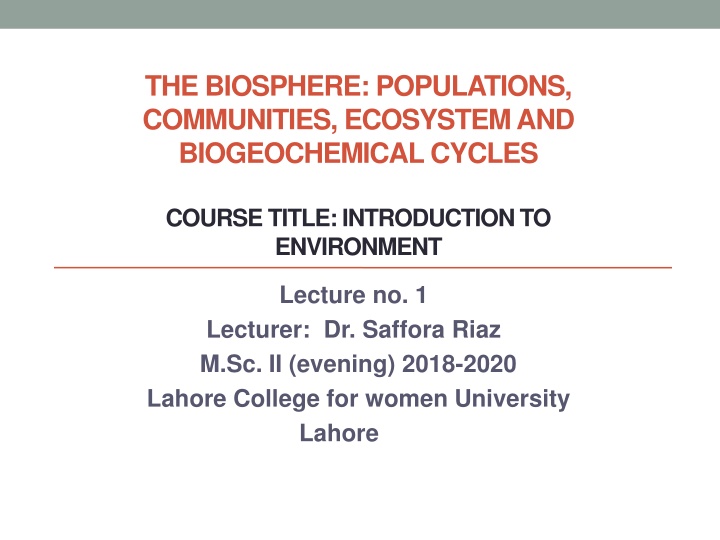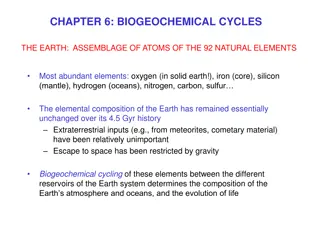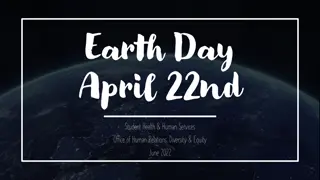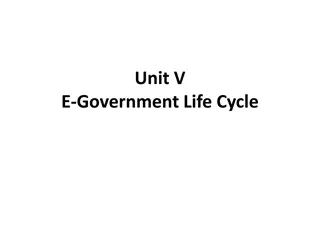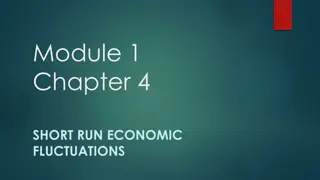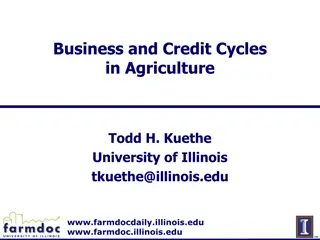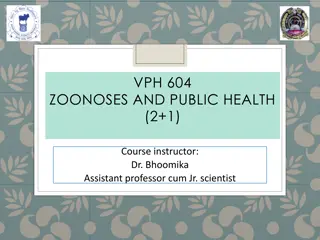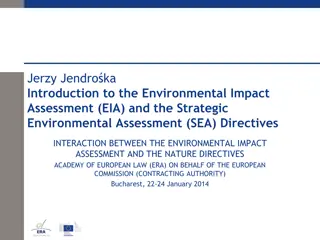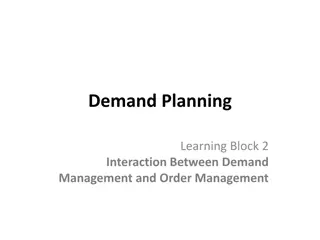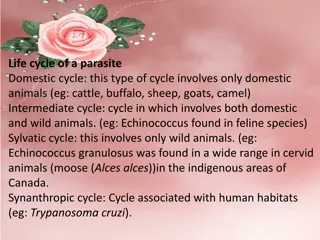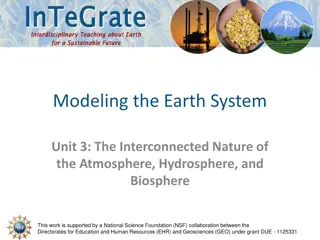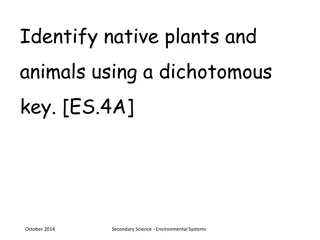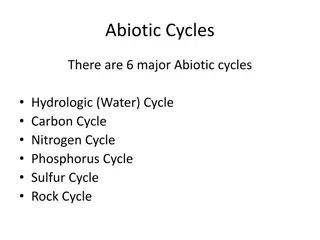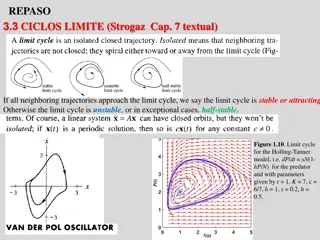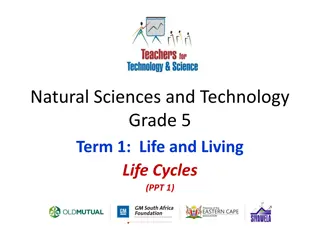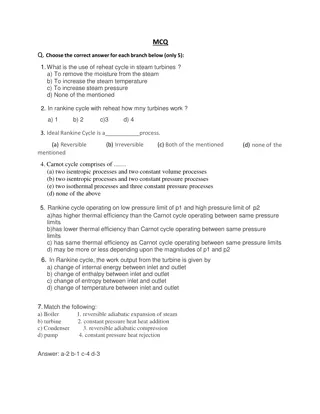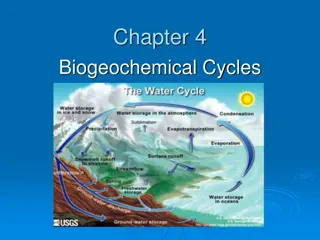The Earth's Environmental Systems and Cycles
Explore the interconnected systems of the Earth's biosphere, lithosphere, hydrosphere, and atmosphere, along with biogeochemical cycles like the hydrological cycle. Learn how these systems interact to sustain life and maintain Earth's dynamic environment over billions of years.
Download Presentation

Please find below an Image/Link to download the presentation.
The content on the website is provided AS IS for your information and personal use only. It may not be sold, licensed, or shared on other websites without obtaining consent from the author.If you encounter any issues during the download, it is possible that the publisher has removed the file from their server.
You are allowed to download the files provided on this website for personal or commercial use, subject to the condition that they are used lawfully. All files are the property of their respective owners.
The content on the website is provided AS IS for your information and personal use only. It may not be sold, licensed, or shared on other websites without obtaining consent from the author.
E N D
Presentation Transcript
THE BIOSPHERE: POPULATIONS, COMMUNITIES, ECOSYSTEM AND BIOGEOCHEMICAL CYCLES COURSE TITLE: INTRODUCTION TO ENVIRONMENT Lecture no. 1 Lecturer: Dr. Saffora Riaz M.Sc. II (evening) 2018-2020 Lahore College for women University Lahore
Environment: All the living things that surrounds us Air, land, oceans and all living things Environment Biological environment Physical environment solid Include all the living things liquid gas
Environment Four spheres compose Natural environment 1 Lithosphere_lithos (rocks) 2 Hydrosphere_hydro (water) 3 Atmosphere_atmos (vapor) 4 Atmosphere_bios (life) These spheres form outermost layer of earth
Three major points 1. four spheres make the Earth Dynamic Planet Lithosphere create rocks by internal heat engine Atmosphere weathers & degrades rocks by chemically reactive gasses Hydrosphere erode rocks & transport them as sediments deposit in ocean basins
continuoue 2. Spheres closely interact with one another Gases released from litho + biosphere to atmosphere 3. Dynamic and interactive sphere evolved through time Earth is about 4.6 billion Y/O Lithosphere originated 4 billion years ago Atmosphere originates 3.8 billion years ago Biosphere originates at least 3.5 billion years
Major Aspects of Physical Environment Earth almost covered with water Atmosphere composed of N2 (78.1%) O2 (20.9%) Atmosphere composed an envelope around earth
Conti. Atmospheric Envelope Troposphere stratosphere Mesosphere Thermosphere Separated from each other on the basis of temp.
Conti.. Earth is an open system in term of Energy Flow 30% of solar energy reflected back to space 19% absorbed by water vapors 51% reaches to earth Less then 1% photosynthesis
Hydrologic cycle Movement of water on earth surface constitutes the Hydrological Cycle 97.4% water in ocean and seas remaining found in form of ice caps, ground water Role shifting of water over the earth weathering and decomposition of rocks
Biosphere interactions Ecology How the organisms interacts with each other and to their physical environment Organisms grouped in Populations communities ecosystem communities Biosphere
Population Dynamic Population Group of individuals of same species living at same place at same time Population under go three distinct phases 1) Growth available resources exceed number individuals able to exploit them 2) Stability environment becomes saturated with the population 3) Decline inevitable decrease in number of individuals that leads to extinction
Conti.. All phases affected by many of factors How these factors interact is called Population Dynamics
Growth of populations All populations have one key trait common Grow exponentially, if left unchecked Intrinsic rate of increase (r) potential for increase of a give population varies among populations by several factors (death and birth rate) Intrinsic rate of increase = Birth rate Death rate
Population stability: Regulation of Growth Growth limited by complex interaction of many factors (including other species) For example Take microbes in a glass Individuals will experience rapid growth (first admitted) At a point, space and food becomes limited Multiplication growth enters to slower growth Continually slow until it reach to population size stabilizes, depends on Carrying capacity
Four basic Abundance controls Factor external to population limits reproductive and survival rate Two basic categories of environment that effect population 1 2 Physical environment Biological environment Physical limitation symbiosis predation competition
Limitations of Physical environment 1. Water supply 2. Space availability 3. Soil 4. Light Physical environment s constrains can determined by habitat of population Example Remaining Florida Panther population lives in a wetland habitat including the Florida Everglades Growth is limited by the resources in the shortest supply (Justus Leibig, 1840)
Biological Environment 1 Competition occurs when both populations require same limited resource Exploitative/ scramble competition both competing population have equal access to resource Interference competition one of the competitors prevents the other from gaining access
Conti Competition determined by organism s niche Niche how the organism fits into local system Competition Exclusion Niche overlap is very great and competition is so intense that one species eliminates the second species from an area Example Paramecium aurelia and closely related species
conti. Ecological release one of the two competing species removed, remaining may increase in number 2. Predation one organism consume other living organisms Predation carnivores herbivores prey on animalsprey on plants
Carnivores Herbivores
Conti.. Predation leads to extinction More commonly, predation limits abundance, do not drive prey to extinction Prey species have protective traits a) camouflage b) poisons c) spines d) large size if prey become scarce, predator switch to other prey Allow the first prey to rebound in numbers
Symbiosis Living together, include many kind of interaction, competition and predation Mutualism benefits both species e.g., coral reef and algae exist in mutualistic relation, supply shelter and food to each other Parasitism One species benefits while harming other Similar to predation
Mutualism Parasitism Parasites, such as leeches, often do not kill their hosts Coral reef and algae .
Commensalism One species benefits other neither infected nor benefited E.g., Spanish moss hangs from trees for support, cause trees no harm or benefit Amensalism one inhabit another while being uninfected itself and accidentally harm the other E.g., elephant crash vegetation, while gaining few benefit
commensalism Amensalism
Population decline Extinction Elimination of all individuals in a group from an area Earth s energy budget The flow of all Pathways of all energy on Earth Nonrenewable resources Take too long to form e.g., Fossil Fuel Renewable resources can be recycle easily e.g., solar energy, tidal energy
